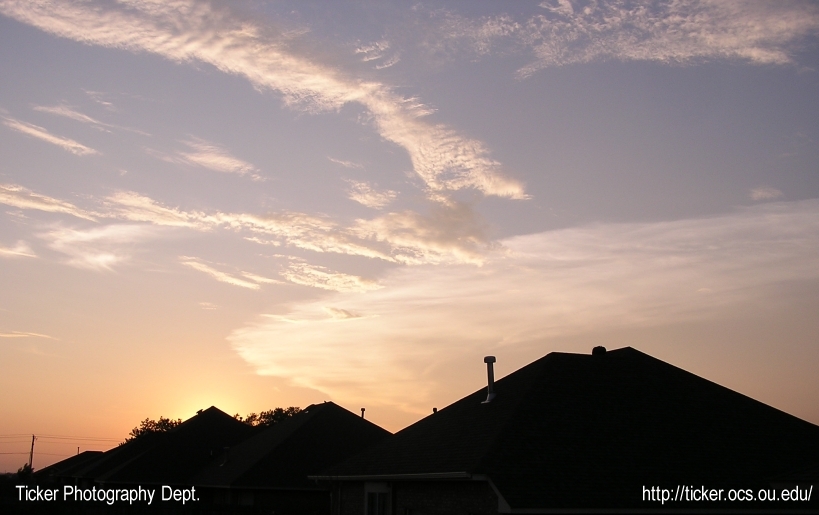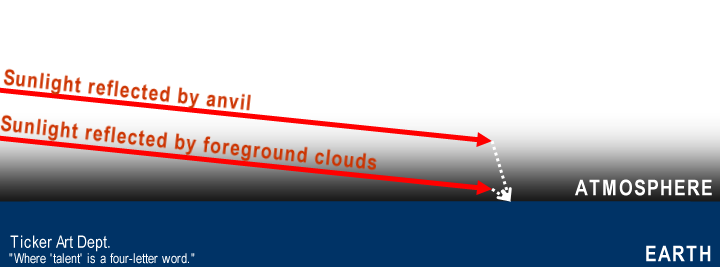Ticker for August 25, 2006
MESONET TICKER ... MESONET TICKER ... MESONET TICKER ... MESONET TICKER ...
August 25, 2006 August 25, 2006 August 25, 2006 August 25, 2006
Clouds Show Signs of Extinction
Today, we have another photo taken at the same time as yesterday's
"anvil" Ticker, this time looking westward toward the setting sun:

A subtle feature: notice the difference in the color characteristics
between the two sets of clouds. The anvil is a more brilliant white,
while the clouds in the foreground have a yellow-pink dullness about
them (the contrast was even more apparent to the naked eye).
Why so? It has to do with extinction. No, not *that* kind of
extinction. We're talking about the elimination of sunlight by
the atmosphere.
The atmosphere's gases scatter visible light's shorter wavelengths
(bluish colors) more than the longer wavelengths (reds, yellows).
A profound consequence of this preferential scattering: our blue sky.
And, at sunset and sunrise, two factors come together to produce
those pretty pinkish colors:
Gravity, which causes concentrates most of the atmosphere's mass
near the surface.
Geometry, which dictates that light coming from very oblique angles
must travel through more atmosphere to reach us.
A picture is worth a thousand equations, so here's a schematic:

The upshot is this: at low sun angles, the light must pass through
more atmosphere, which means more "extinction" of bluish light, which
leaves us with pretty colors (golds that become oranges that become
reds as the sun gets lower and lower).
So this process left us with the pinkish-gold light that illuminated
the clouds in the foreground. But why is the the anvil white? Because
it was tens of thousands of feet above the surface. And, even though
the sun struck the anvil at essentially the same angle as the lower
clouds, the atmosphere is much, much thinner up there (to be fair,
the anvil was farther west, so the sun was very slightly higher in
its sky). This means that the light that hit the anvil passed by
fewer molecules, which scattered less bluish light, so the anvil was
illuminated by whiter light than the foreground clouds. Again, a
picture helps, uh, illuminate this:

From an extinction point-of-view, the relatively short trips from
anvil-to-eye and other-clouds-to-eye aren't significantly different.
By the way, this extinction thing explains why stars are duller
(and redder!) on the horizon versus when they're overhead.
August 25 in Mesonet History
| Record | Value | Station | Year |
|---|---|---|---|
| Maximum Temperature | 109°F | FREE | 2024 |
| Minimum Temperature | 46°F | BEAV | 2010 |
| Maximum Rainfall | 4.69″ | MEDI | 2017 |
Mesonet records begin in 1994.
Search by Date
If you're a bit off, don't worry, because just like horseshoes, “almost” counts on the Ticker website!